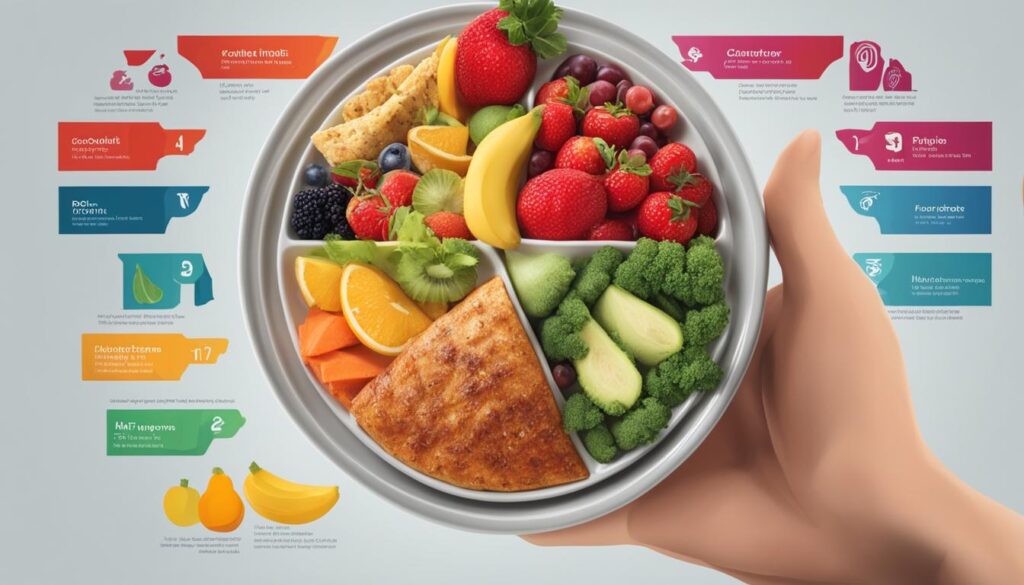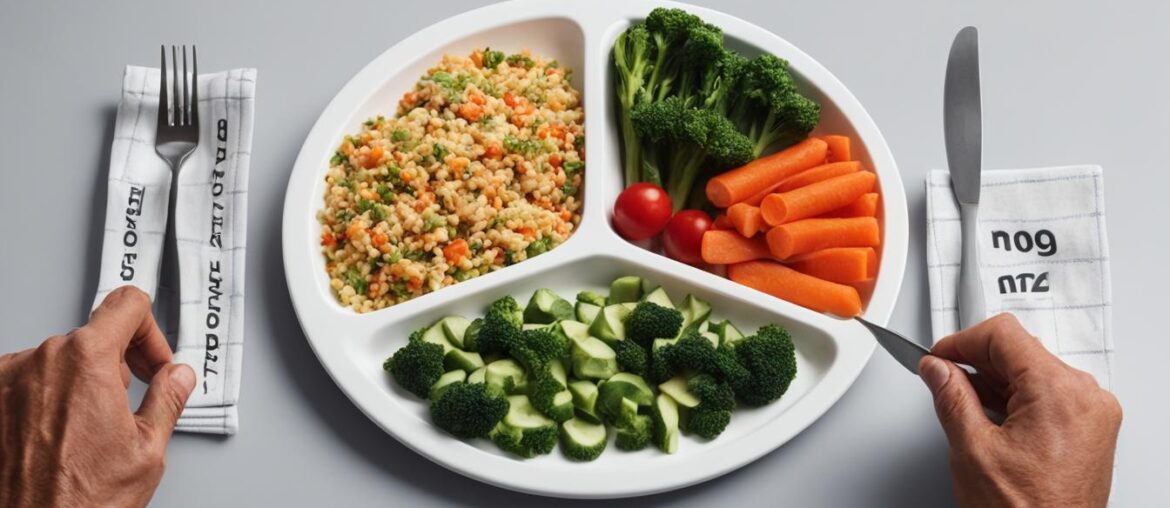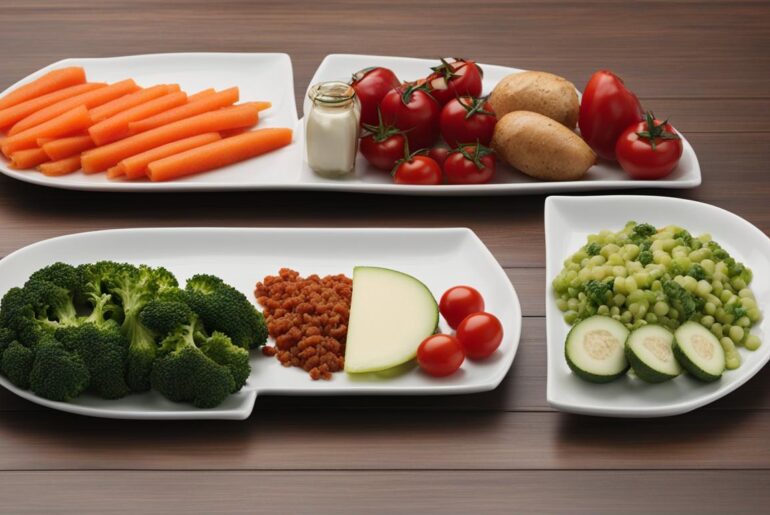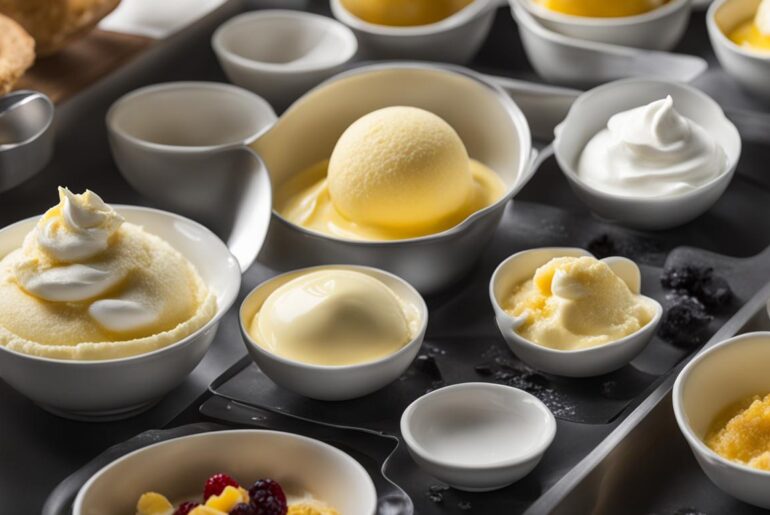Obesity is a growing epidemic, and controlling portion sizes plays a crucial role in preventing overeating and weight gain. The size of our plates can unconsciously impact how much food we consume. Using smaller dinnerware, such as plates, spoons, and glasses, can help us regulate our portion sizes effectively. In this article, I will discuss the recommended plate size for portion control, providing guidance on achieving a balanced meal to support weight management.
Key Takeaways:
- Choosing smaller dinnerware can help prevent overeating.
- Using a plate as a portion guide can promote a well-balanced meal.
- Your hands can serve as a practical guide for portion sizes.
- Implementing portion control strategies can support weight management (check out my post on portion control strategies here).
- Awareness of suitable serving sizes and keeping a food diary can contribute to portion control success.
Use Smaller Dinnerware
Research suggests that using smaller plates, dishes, and bowls can unconsciously influence how much food someone eats. For example, studies have shown that using large plates can make food appear smaller, leading to overeating. Swapping larger dishes for smaller alternatives can reduce the amount of food and prevent overeating.
“Most people feel just as full having eaten from a smaller dish as from a large one.”
Therefore, using smaller dinnerware is a simple and effective way to control portion sizes and prevent overindulging.
By switching to smaller plates, dishes, and bowls, individuals can visually perceive a portion that fills up the plate, promoting a sense of satisfaction. This can help prevent overeating and encourage mindful eating habits. Using smaller dinnerware not only aids portion control but also creates a psychological illusion of a more substantial meal, satisfying the mind and stomach alike.
In addition to reducing the risk of overeating, smaller dinnerware can also contribute to weight management. By controlling portion sizes and consuming fewer calories, individuals can create a calorie deficit that supports weight loss or weight maintenance goals.
In conclusion, incorporating smaller dinnerware into your daily eating habits can be an effective strategy for portion control and preventing overeating (see my post here).
Use Your Plate as a Portion Guide
Using a plate as a guide for portion control can help curb total food intake and ensure a well-balanced meal. Dividing the plate into sections based on different food groups can help determine the optimal macronutrient ratio.
A rough guide for each meal is as follows:
- Fill half of the plate with vegetables or salad, which are low in calories but high in fiber and nutrients.
- Allocate a quarter of the plate for high-quality protein sources to support muscle growth and repair.
- Devote another quarter of the plate to complex carbohydrates, such as whole grains or starchy vegetables, for sustained energy.
- Include half a tablespoon of high-fat foods, such as olive oil or avocado, to provide essential nutrients and promote satiety.
This plate portion guide can be customized based on individual dietary needs and preferences. However, the emphasis should always be on filling up on vegetables and salad to create a balanced meal.
For extra guidance in dividing the plate into sections for different food groups, using a portion control plate can be beneficial. These plates typically have dividers or designated areas for each category, making it easier to achieve optimal portion sizes and create a visually appealing meal.
| Food Group | Proportion of Plate |
|---|---|
| Vegetables or Salad | 50% |
| High-Quality Protein | 25% |
| Complex Carbohydrates | 25% |
| High-Fat Foods | 0.5 tbsp |
Use Your Hands as a Serving Guide

Another practical way to determine appropriate portion sizes without relying on measuring tools is by using your hands as a serving guide. Hands often correspond to body size, meaning that individuals with larger hands usually require more food. By utilizing your hands as a reference, you can estimate portion sizes for different food groups, making portion control easier and more accessible.
Here’s a rough guide for each meal:
- High-Protein Foods: For women, aim for a palm-sized serving, while men should have two palm-sized portions.
- Vegetables and Salads: Women should aim for a fist-sized portion, while men can have two fist-sized portions.
- High-Carb Foods: For women, a cupped-hand portion is sufficient, while men can have two cupped-hand portions.
- High-Fat Foods: Women should stick to a thumb-sized portion, while men can have two thumb-sized portions.
Different food groups correspond to various shapes and parts of the hands, enabling you to approximate portion sizes easily. This method eliminates the need for precise measurements and offers a practical approach to portion control.
Example:
“Using your hands as a serving guide is a simple yet effective way to ensure proper portion sizes. A palm-sized serving of protein, a fist-sized portion of vegetables, a cupped-hand portion of carbs, and a thumb-sized portion of fats can help maintain a balanced diet and prevent overeating.”
| Food Group | Portion Size (Women) | Portion Size (Men) |
|---|---|---|
| High-Protein Foods | Palm-sized | Two palm-sized portions |
| Vegetables and Salads | Fist-sized | Two fist-sized portions |
| High-Carb Foods | Cupped-hand portion | Two cupped-hand portions |
| High-Fat Foods | Thumb-sized portion | Two thumb-sized portions |
Conclusion
Controlling portion sizes is crucial for managing weight and preventing overeating. By implementing a combination of effective portion control strategies, individuals can achieve their desired weight management goals. One important strategy is using smaller dinnerware, such as plates, bowls, and glasses. Research shows that using smaller dishes can help reduce the amount of food consumed and prevent overindulging.
Another effective strategy is using a plate as a portion guide. Dividing the plate into sections for vegetables, high-quality protein, complex carbs, and high-fat foods ensures optimal portion sizes and a well-balanced meal. This simple method helps individuals maintain portion control and the appropriate macronutrient ratio.
Additionally, using hands as a serving guide is a practical way to gauge portion sizes without the need for measuring tools. Different food groups correspond to various shapes and parts of the hands, making it easy to estimate appropriate portion sizes. By following these serving guidelines, individuals can also achieve a well-rounded meal.
Implementing portion control strategies, combined with finding the optimal plate size, can significantly contribute to weight management efforts (see my post here). By being mindful of portion sizes, individuals can control their food intake, prevent overeating, and ultimately achieve a healthy plate size and maintain a healthy weight.




